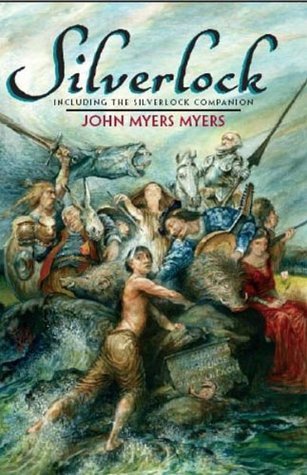
By chance I ran across John Myers Myers’ Doc Holliday (1955) when I was knocking about some used bookstore with my Dad, or perhaps in one of those fabulous pokey places in Florida tourist traps. It was engaging and turned my passing curiosity about Doc Holliday into a full blown obsession. I read several more books about Holliday since, but it was only recently that I went looking for Myers’ book again and started investigating his writing. John Myers Myers was a writer who seemed to tackle anything. He wrote for newspapers, novels, and historical works. His most well known book, Silverlock, exposes just how much he also consumed other people’s writing [wikipedia].
Silverlock is a reader’s book. And I mean the challenge of getting every reference to classical and popular literature is well known among people who have read and loved Silverlock. The main character of the book washes ashore on the Commonwealth of Letters, a Land of Story. As the main character moves through his own journey he encounters characters, battles, and lands living their own stories in real life. The references within are the kind that make you glad you suffered through all that assigned reading in literature, classics, and history classes. Newer editions of Silverlock include descriptions of an intriguing fan subculture that the internet seems to have never learned about.

According to Deuce Richardson (2021), just after Silverlock came out in 1949 it disappeared, but the dearth of sci-fi fantasy in the 1950s made it a popular read via word of mouth. According to the Silverlock Companion, published together with the original story as Silverlock: Including the Silverlock Companion (Nesfa’s Choice, 26), this word of mouth community included writing and performing melodies to the many songs recorded as poetry within the story.
In an addition I managed to find first, an introduction by Poul Anderson heaped praise upon the book and described the subculture as though it was something vast and far reaching. Richardson (2021) talks of the fandom spreading through Anderson’s circle. Perhaps the subculture was relegated to a tight knit group of friends.
I can’t say I have many people to whom I would recommend Silverlock, if only because it is a hefty and challenging read that is only improved by knowledge of a great deal of other books, though this knowledge is not required. I am excited to read more of John Myers Myers work, especially his non-fiction and historical fiction.
Readings
- Richardson, D. (2018). John Myers Myers: From Conan To Doc Holliday. DMR Books Blog.
- Richardson, D. (2021). Silverlock by John Myers Myers. DMR Books Blog.
